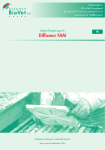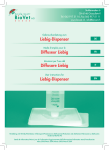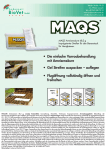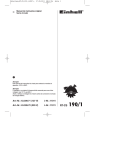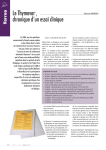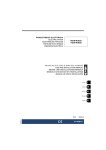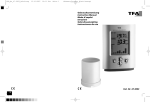Download FAM-Dispenser Diffusore FAM Diffuseur FAM FAM
Transcript
Stahlermatten 6 CH – 6146 Grossdietwil Tel. +41 62 917 5110 Fax +41 62 917 5111 www.biovet.ch [email protected] Gebrauchsanleitung zum FAM-Dispenser Mode d‘emploi pour le Diffuseur FAM Istruzioni per l‘uso del Diffusore FAM User instructions for FAM-Dispenser Herstellung und Vertrieb / Distributeur et fabriquant / Produzione e distribuzione / Production and distribution: Andermatt BioVet AG Stand der Information / Mise à jour de l’information / Aggiornamento dell‘informazione / Information stand: März 2012 / Mars 2012 / Marzo 2012 / March 2012 DE Seite 2 FR page 3 IT pagina 5 EN page 6 1. Aufbau Deutsch Der FAM-Dispenser besteht aus drei Teilen: Deckel mit drehbarer Scheibe Schwammtuch Boden Aussenmasse 253 x 253 x17 mm 2. Funktionsweise Die Ameisensäure wird durch das Schwammtuch vollständig aufgesogen. Durch Drehen der Scheibe werden die Öffnungen des Deckels mehr oder weniger geöffnet. Dadurch kann die Verdunstungsmenge der Ameisensäure der Beute und der Temperatur angepasst werden. Der Dispenser wird mit den Öffnungen nach unten auf das Brutnest gelegt und die Ameisensäure dampft langfristig ins Volk ab. Die Ameisensäure-Dämpfe sind schwerer als die Stockluft und fallen nach unten direkt ins Volk. Der Dispenser besteht aus Polystyrol und ist mehrere Jahre einsetzbar. Die Schwammtücher sind ebenfalls mehrmals verwendbar, wenn sie zwischen den Behandlungen leicht feucht aufbewahrt werden. 3.3 Befüllen des FAM-Dispensers Den Deckel des FAM-Dispensers mittels den abstehenden Laschen vom Boden abnehmen. Es sollte sichergestellt werden, dass keine restliche Ameisensäure oder Feuchtigkeit von vorausgegangenen Behandlungen im Schwammtuch vorhanden ist. Den Boden mit dem eingelegten Schwammtuch auf eine waagrechte Fläche stellen. Für beide Behandlungen (Juli und September) je 130 ml 70 % Ameisensäure auf das Schwammtuch giessen. Anschliessend den Dispenser so schliessen, dass der Deckel in allen vier Ecken einrastet. Gefüllte FAM-Dispenser stets waagrecht halten, so dass keine Säure auslaufen kann. 3.4 Einstellen der Öffnungen ( Verdunstungsmenge ) Durch Drehen der Scheibe werden die Öffnungen des Deckels mehr oder weniger geöffnet. Dadurch kann die Verdunstungsmenge der Ameisensäure der Beute und den zu erwartenden Tageshöchsttemperaturen angepasst werden. Die drehbare Scheibe mit dem Zeiger gemäss untenstehender Tabelle einstellen. Die Ziffern in der Tabelle ( Öffnungsstufen ) entsprechen den eingepressten Ziffern auf dem Deckel des FAMDispensers. Tageshöchsttemperatur Öffnungsstufe des FAM-Dispensers Schweizer Kasten Dadant Beuten 3. Gebrauchsanweisung 3.1 Behandlungszeitpunkte Erste Behandlung Der FAM-Dispenser wird möglichst früh ( Juli) unmittelbar nach dem Abernten im Sommer eingesetzt ( Dauer: 7 Tage ). Vor der Behandlung ist eine einmalige Fütterung empfohlen. Tipp: Offene Böden bereits eine Woche vor Beginn der Behandlung schliessen. Ein gleichzeitiges Erfassen des natürlichen Milbenfalls gibt Anhaltspunkte über die Dringlichkeit der ersten Behandlung. Zweite Behandlung Vor der zweiten Behandlung sollten die Völker fertig aufgefüttert werden. Ab Mitte September wird der Dispenser für 14 Tage ins Volk eingelegt. Tipp: Dispenser unmittelbar nach der Behandlung aus dem Volk nehmen. 3.2 Sicherer Umgang mit Ameisensäure Ameisensäure ist stark ätzend. Der Umgang mit ihr erfordert grosse Vorsicht. In jedem Fall Schutzbrille, säurefeste Gummihandschuhe und langärmlige Bekleidung tragen. Spritzer auf die Haut müssen sofort gründlich mit Wasser abgewaschen werden. Wasser bereitstellen! Bei Berührung mit den Augen sind diese gründlich mit Wasser auszuspülen. Sofort einen Arzt konsultieren! Bereits verwendete Schwammtücher immer mit Handschuhen anfassen! 2 Schweizer Jungvolkkasten mit reduziertem Beutevolumen ( 7 – 8 Brutwaben) 1. Behandlung ( Juli); Dauer 7 Tage 15 – 20 °C 3 4 2 20 – 25 °C 2 3 1 25 – 30 °C 1 für die ersten 2 Tage 2 für die ersten 2 Tage 1 für die ersten 2 Tage 3 ab dem dritten Tag 4 ab dem dritten Tag 2 ab dem dritten Tag 2. Behandlung (ab Mitte Sept); Dauer 14 Tage 10– 15 °C 5 5 4 15– 20 °C 4 4 3 20– 25 °C 3 3 2 *Zu erwartende Temperaturhöchstwerte im Schatten gemäss Wetterprognosen für den ersten Behandlungstag. Bei anderen Bedingungen, welche nicht in der Tabelle beschrieben sind, oder anderen Beutetypen empfiehlt es sich eigene Erfahrungen zu sammeln ( z.B. Einzargige Zander- oder Langstroth-Beuten entsprechen annähernd dem Schweizer-Kasten, während zweizargige DNMBeuten ungefähr Dadant-Beuten entsprechen ). 1. Montage Le Diffuseur FAM se compose de trois pièces: Français 3.5 Einlegen des FAM-Dispensers ins Volk Den FAM-Dispenser während den kühlen Morgenstunden einlegen. Auf dem Bienenstand: 1. Überprüfen ob Beuten gut schliessen. Offene Gitter- böden sind eine Woche vor Behadlungsbeginn zu schliessen. Die Bienen sollen sich an die neuen Ventilationsverhältnisse gewöhnen. 2. Kontrollieren ob die Öffnungen des FAM-Dispensers gemäss Tabelle ( Punkt 3.4 ) eingestellt sind. 3. Volk öffnen und sicherstellen, dass auf dem Volk ein genügender Hohlraum für den Dispenser vorhanden ist. ( Den ersten Honigraum oder bei Magazinen ein umgedrehtes Futtergeschirr oder einen 5 cm hohen Rahmen geben. ) 4. Zwei Hölzer mit ca. 2 cm Höhe oder ein leeres Honigrähmchen auf die Brutwaben legen. FAMDispenser mit den Öffnungen nach unten auf die Hölzer bzw. das Honigrähmchen legen. Der Abstand bewirkt, dass keine Verdunstungsöffnungen zugedeckt werden. 5. Volk mit Deckbrettern oder Deckel dicht schliessen, um Ameisensäure-Verlust zu minimieren. 6. Fluglöcher bis auf eine Länge von mindestens 15 cm und nach Möglichkeit bis auf eine Höhe von 2 cm öffnen. 7. FAM-Dispenser entfernen sobald alle Ameisensäure verdunstet ist ( je nach Behandlungszeitpunkt nach 7 resp. 14 Tagen ). Jungvolkkästen Bei Jungvolkkästen mit kleinen Fluglöchern den Gitterboden nicht ganz schliessen. Der Varroaschieber sollte ca. 2 cm zurückgezogen werden. Ein komplett offener Gitterboden kann zu einem Wirkungsverlust von bis zu 20 % führen. 4. Mögliche Nebenwirkungen le couvercle avec un disque rotatif l’éponge en tissu le fond Les mesures extérieures sont 253 x 253 x 17 mm. 2. Mode de fonctionnement L’acide formique est complètement absorbé par l’éponge en tissu. En tournant le disque rotatif, les ouvertures du couvercle sont plus ou moins ouvertes. Ainsi la quantité d’acide formique diffusée peut être adaptée à la ruche et à la température. Le Diffuseur FAM est placé sur le nid à couvain et l’acide formique s’évapore lentement dans la colonie. Les vapeurs d’acide formique sont plus lourdes que l’air dans la ruche et descendent directement dans la colonie. Le diffuseur est en polystyrol et est réutilisable de nombreuses années. Conservés légèrement humidifiés, les tissus-éponges sont également réutilisables. 3. Mode d’emploi 3.1 Période de traitement Le premier traitement Le Diffuseur FAM doit être utilisé le plus tôt possible ( juillet ), juste après la récolte de fin d’été et ce premier traitement durera 7 jours. Avant le traitement il est recommandé de nourrir les abeilles une fois. Conseil: Fermer les fonds ouverts une semaine avant le début du traitement. Un contrôle simultané de la chutenaturelle des acariens vous donne une idée de l’urgence du premier traitement. Junge Brut und schlupfreife Bienen reagieren besonders sensibel auf Ameisensäure, weshalb eine gut wirkende Ameisensäurebehandlung immer zu gewissen Brutverlusten führt. Diese Verluste haben jedoch gemäss Untersuchungen keinen negativen Einfluss auf die spätere Volksentwicklung. Le deuxième traitement Avant le deuxième traitement, terminez le nourrissement. Dès mi-septembre, placez le Diffuseur FAM pendant 14 jours dans la colonie. Speziell bei hohen Temperaturen (> 25 °C) und alten Königinnen ist Vorsicht geboten. Bei Tageshöchsttemperaturen von über 30 °C keine Ameisensäurebehandlung durchführen. 3.2 Manipulation sûre de l’acide formique L’acide formique est fortement corrosif. Sa manipulation doit être effectuée avec la plus grande précaution. Dans tous les cas, il faut porter des lunettes de protection, des gants en caoutchouc et des vêtements à manches longues. Les éclaboussures sur la peau doivent être rincées tout de suite à grande eau. Préparer un récipient d’eau à cet effet! Lors de contact de l’acide avec les yeux, il faut les laver soigneusement avec de l’eau. Consulter immédiatement un médecin! Manipulez toujours les éponges en tissu ayant déjà servi avec des gants. 5. Winterbehandlung / Restentmilbung Die abschliessende Winterbehandlung der brutfreien Völker mit Oxalsäure ( z. B. OXUVAR® ) stellt sicher, dass die Bienen mit möglichst wenig Milben in die folgende Bienensaison starten. Conseil: Après le traitement, ôtez de suite le Diffuseur FAM de la colonie. 3 3.3 Remplissage du Diffuseur FAM Le couvercle du Diffuseur FAM est détaché de son socle en utilisant les languettes triangulaires. Il est important de vérifier au préalable qu’il n’y ait aucun reste d’acide formique provenant d’un traitement antérieur dans l’éponge en tissu. Placez le fond du diffuseur qui contient l’éponge sur une surface horizontale et plane. Pour les deux traitements (en juillet et en septembre) versez toujours la dose de 130 ml d’acide formique 70 % sur l’éponge en tissu. Finalement, fermez le diffuseur de telle manière que le couvercle soit bien fixé aux quatre coins. Tenir les diffuseurs remplis horizontalement, afin que l’acide ne puisse pas s’écouler. 3.4 Ajustage des ouvertures (quantité évaporée) En tournant le disque rotatif il est possible d’ouvrir plus ou moins les ouvertures du couvercle. Ainsi, la quantité d’acide formique évaporée peut être adaptée à la ruche et aux températures maximales journalières attendues. Ajustez le disque rotatif avec sa flèche, selon le tableau ci-contre. Les chiffres dans le tableau (degrés d’ouverture) correspondent aux chiffres imprimés sur le couvercle du Diffuseur FAM. Température journalière maximale* Ouverture du Diffuseur FAM Ruches suisses Ruches Dadant Nucléus avec 7-8 rayons à couvain 1. traitement ( juillet); durée 7 jours 15 – 20 °C 3 4 2 20 – 25 °C 2 3 1 25 – 30 °C 1 pour les 2 premiers jours 2 pour les 2 premiers jours 1 pour les 2 premiers jours 3 4 dès le 3ème jour dès le 3ème jour 2 dès le 3ème jour 2. traitement ( à partir de mi-septembre); durée 14 jours 10– 15 °C 5 5 4 15– 20 °C 4 4 3 20– 25 °C 3 3 2 *Températures maximales attendues à l’ombre selon les prévisions météorologiques pour le premier jour de traitement. Pour des conditions autres que celles décrites dans le tableau ou pour d’autres systèmes de ruches, il y a lieu de faire ses propres expériences (par ex. les ruches Zander ou Langstroth à un magasin correspondent plutôt aux ruches suisses, alors que les ruches DNM à deux magasins se rapprochent des ruches Dadant.) 3.5 Pose du Diffuseur FAM dans la colonie Le Diffuseur FAM doit être mis en place tôt le matin, lorsque les températures sont encore fraîches. Dans le rucher: 1. Contrôlez si les ruches sont bien fermées. Fermez les fonds grillagés une semaine avant l‘application. Les abeilles doivent s‘accoutumer au nouveau régime de ventilation. 2. Contrôlez si les ouvertures du Diffuseur FAM sont bien ajustées selon le point 3.4. 3. Ouvrez la colonie et assurez-vous qu’il y ait suffisamment d’espace libre pour le diffuseur au dessus de la colonie. (Mettez à disposition une hausse, ou bien, dans une ruche à magasin, un nourrisseur vide ou un cadre réhaussé de 5 cm de haut.) 4. Placer deux morceaux de bois de 2 cm de section ou un cadre à miel vide sur les cadres de couvain. Mettre le Diffuseur FAM sur les bots de bois, resp, sur le cadre à miel vide, l‘ouverture vers le bas. Cet espace empêche que les ouvertures d‘évaporation ne soient pas couvertes. 5. Fermez la ruche bien hermétiquement pour minimiser des pertes d’acide formique. 6. Ouvrez les trous de vol sur une largeur de 15 cm au moins et si possible sur 2 cm de haut. 7. Retirez le Diffuseur FAM dès que tout l’acide formique est évaporé (selon la date de traitement, après 7 resp. 14 jours). Nucléus Sur les nucléus avec petits trous d‘envoi, ne pas fermer complètement le fond d‘aération. La grille d‘aération devrait être ouvert d‘environ 2 cm. Un fond grillagé complètement ouvert peut entrainer une perte d‘efficacite de 20 %. 4. Effets secondaires possibles Les jeunes larves et les abeilles prêtes à éclore sont particulièrement sensibles à l’acide formique, c’est pourquoi il s’ensuit toujours une certaine perte de couvain. Selon les recherches, ces pertes n’ont aucune influence négative sur le développement futur de la colonie. Lorsque les températures sont particulièrement hautes (>25 °C) et que les reines sont âgées, il faut prendre garde. Lorsque les températures maximales journalières sont supérieures à 30 °C, il ne faut pas entreprendre de traitement. 5. Traitement hivernal Le traitement complémentaire d’hiver dans les colonies sans couvains à l’acide oxalique ( p. ex. OXUVAR® ) permet de s’assurer que les abeilles démarrent la saison suivante avec un minimum d’acariens. 4 Il Diffusore FAM è composto da tre parti: un coperchio con dischetto girevole un panni-spugna una robusta base Dimensioni esterne 253 x 253 x 17 mm. 2. Funzionamento L’acido formico viene completamente assorbito dal pannispugna. Le aperture del coperchio vengono regolate tramite rotazione del dischetto. In questo modo viene regolata la quantità d’evaporazione di acido formico a seconda dell’arnia e della temperatura. Il diffusore viene collocato con le aperture rivolte verso il basso al di sopra dei favi di covata. L’acido formico si diffonde lentamente nella colonia. I vapori rilasciati dall’acido formico sono più pesanti dell’aria nell’alveare e cadono così direttamente verso il basso nella colonia. Il diffusore è in polistirolo e può essere utilizzato per diversi anni. Anche i panni-spugna sono riutilizzabili, sempreché vengano mantenuti leggermente umidi tra un trattamento e l’atro. 3. Modo d’uso 3.1 Quando effettuare il trattamento Primo trattamento Il Diffusore FAM deve essere utilizzato subito dopo la raccolta del miele (luglio) nella tarda estate (durata 7 giorni). Prima del trattamento si consiglia di nutrire le colonie una volta. Suggerimento: Chiudere i suoli apperiti una settimana prima del trattamento. E cosigliato di rilevare l’infestazione naturale del acaro varoa, cho può dare un’idea dell’urgenza del primo trattamento. Secondo trattamento Prima del secondo trattamento si consiglia di procederealla completa nutrizione delle colonie. Dal metà settembre circa viene collocato il diffusore nella colonia per la durata di 14 giorni. Consiglio: Rimuovere il diffusore dalla colonia dopo la fine del trattamento. 3.2 Manipolazione sicura dell’acido formico L’acido formico è altamente corrosivo. Nella sua manipolazione occorre grande prudenza. E’ necessario portare degli occhiali protettivi, guanti di gomma e indumenti a maniche lunghe. Sciacquare immediatamente eventuali schizzi sulla pelle. Tenere dell’acqua a portata di mano! In caso di contatto con gli occhi, sciacquare a fondo con acqua e poi consultare un medico. Usare sempre guanti di gomma per panni spugna già utilizzati. 3.3 Riempimento del Diffusore FAM Il coperchio del Diffusore FAM viene staccato dal corpobase attraverso una linguetta sporgente. Bisogna assicurarsi che non siano presenti resti di acido formico da trattamenti precedenti nel panni-spugna. Sistemare la robusta base con il panni-spugna su una superficie orizzontale. Per entrambi i trattamenti (luglio e settembre) vengono utilizzati ogni volta 130 ml al 70 % di acido formico versati sul panni-spugna. Alla fine chiudere il diffusore in modo che il coperchio scatti in posizione di tutti e quattro gli angoli. Tenere il Diffusore FAM, una volta riempito, sempre in posizione orizzontale in modo da impedire qualsiasi perdita di acido formico. 3.4 Regolazione delle aperture ( quantità di evaporazione ) Tramite rotazione del dischetto viene regolata l’aperturadel coperchio. In questo modo viene regolata la quantità di evaporazione a seconda delle colonie e della massima temperatura diurna. Regolare il dischetto girevole con l’indice secondo la tabella sottostante. Le cifre della tabella (grado di apertura) corrispondono alle cifre impresse sul coperchio del Diffusore FAM. Temperatura massima* Grado di apertura del Diffusore FAM Arnia svizzera Arnia Dadant Arnia svizzera delle giovani colonie (7-8 favo) 1. trattamento ( luglio); durata 7 giorni 15 – 20 °C 3 4 20 – 25 °C 2 3 1 25 – 30 °C 1 per i primi due giorni 2 per i primi due giorni 1 per i primi due giorni 3 a partire dal 4 a partire dal terzo giorno terzo giorno 2 2 a partire dal terzo giorno 2. trattamento ( dal metà settembre); durata 14 giorni 10– 15 °C 5 5 4 15– 20 °C 4 4 3 20– 25 °C 3 3 2 *Temperatura massima giornaliera misurata all’ombra secondo leprevisioni meteorologiche per il primo trattamento. In condizioni diverse da quelle illustrate nella tabella o qualora venissero utilizzati altri modelli di arnia si consiglia di basarsi sulla propria esperienza (è noto, ad es., che le arnie Zander o Langstroh a telaiatura semplice corrispondono all’arnia svizzera e le arnie DNM a telaiatura doppia all’incirca all’arnia Dadant). 5 Italiano 1. Struttura English 3.5 Collocamento del Diffusore FAM nelle colonie Il Diffusore FAM va utilizzato nelle prime ore del mattino quando l’aria è fresca. Nell’apiario: 1. Controllare se le arnie sono chiuse bene. Grate di fon do sono da chiudere una settimana prima dell’inizio della cura, per abituare le api alla nuova ventilazione. 2. Controllare se le aperture del Diffusore FAM sono regolate secondo il punto 3.4. 3. Aprire l’arnia e assicurarsi che sia presente un vano vuoto per il diffusore. (Introdurre un vano miele o un nutritore capovolto nelle arnie magazzino oppure un telaio alto 5 cm. 4. Poggiare sulle favi di covata due pezzi di legno con ca. 2 cm di diametro oppure una piccola cornice di miele vuota. Poggiare il Diffusore FAM con le aperture in giù sui pezzi di legno o sulla cornice di miele. La distanza fa sì che non vengano coperte le aperture di evaporazione. 5. Chiudere l’arnia ermeticamente un coperchio per evitare perdite di vapore di acido formico. 6. Aprire I fori di volo fino ad una lunghezza minima di 15 cm e secondo le possibilità, fino ad un’altezza di 2 cm. 7. Rimuovere il Diffusore FAM una volta che tutto l’acdo formico è evaporato (a seconda di quando viene effettuato il trattamento dopo 7 rispettivamente 14 giorni). Arnie delle giovani colonie Nelle arnie delle giovani colonie con piccoli fori di volo, la grata di fondo non và chiusa completamente. L’apposito fondo di controllo varroa dovrebbe essere ritirato ca. 2 cm. Una grata di fondo completamente aperta può causare una perdita di efficacia fino al 20 %. 4. Possibili controindicazioni Le giovani covate e le api pronte a sfarfallare sono molto sensibili all’acido formico e per questo motivo un trattamento di acido formico porta sempre a delle perdite di covate. Queste perdite non hanno tuttavia alcun influsso negativo sullo sviluppo delle colonie future, come rilevato da ricerche. È necessario prestare la massima prudenza quando ci sono temperature elevate (>25 °C) e quando sono presenti vecchie regine. Non effettuare alcun trattamento con acido formico se la temperatura massima diurna supera i 30 °C. 5. Trattamento complementare Le finale trattamento acaricida invernale con l’acidio ossalico ( p. e. OXUVAR® ) dev’essere eseguito in assenza di covata opercolata. Questo trattamento garantisce che le api comminciano la prossima stagione poco infestate. 6 1. Construction The FAM-Dispenser is made of three parts: top with rotatable disc sponge bottom The external dimensions are 253 x 253 x 17 mm. 2. Mode of operation The sponge completely absorbs the formic acid. By turning the disc, the openings of the top will be open more or less. This way the evaporated quantity of the formic acid can be adjusted to the hive and the temperature. The dispenser is placed over the brood chamber with the openings facing downwards and the formic acid is evaporating in the long-term into the colony. The dispenser is made of polysterol and can be used several years. The sponge can be used several times if stored slightly moist in between the treatments. 3. User instruction 3.1 Time First treatment The FAM-Dispenser is used as early as possible ( July ) after the honey harvest in late summer (duration: 7 days). Before the treatment a short feeding is recommended. Tip: Open mesh floor should be closed one week before the treatment starts. At the same time, a control of the natural mite-fall helps to decide if the first treatment needs to be started at once. Second treatment Finish feeding before the second treatment. From mid September the dispenser is placed in the colony for 14 days. Tip: Take the dispenser out of the colony immediately after the treatment. 3.2 Safe use of formic acid Formic acid is highly corrosive. It has to be handled with great care. In any case protective glasses, acidproof gloves and long-sleeved clothes should be worn. Splashes on the skin have to be washed off thoroughly at once. Have water ready! If in contact with the eyes wash thoroughly with water. Consult a doctor immediately! Used sponges must be handled with rubber gloves only. 3.3 Filling of the FAM-Dispenser The top of the FAM-Dispenser is removed by means of the ears of the bottom part. Ensure that there is no formic acid residue from previous treatments in the sponge. Place the bottom with the sponge inside on a horizontal surface. For each treatment (July and September) 130 ml of formic acid 70 % is poured on the sponge. Close the cover of the dispenser engaging it in all four edges. Keep the filled dispenser always in a horizontal position to be sure that there is no acid running out. 3.4 Adjustment of the openings (evaporation rate) Turning the disc of the cover the FAM-Dispenser will be more or less opened. Doing so the evaporation rate of the formic acid can be adjusted to the hive and to the expected daily maximum temperatures. Adjust the rotatable disc with the indicator according to the following table. The numbers in the table (opening grades) correspond to the imprinted numbers on the top of the FAM-Dispenser. Daily max. temperature* Opening of the FAM-Dispenser Swiss hive Dadant hive Nucleus with 7-8 broad combs 1. treatment ( july); duration 7 days 4. Place two pieces of wood of 2 cm height or an empty super-frame over the brood. Place the dispenser with the openings facing downwards on the pieces of wood or on the super-frame. The space prevents the covering of the evaporation openings. 5. Close the hive tight with cover boards to reduce the loss of formic acid. 6. Open the entrances of the hive to a length of at least 15 cm and if possible to a hight of 2 cm. 7. Remove the FAM-Dispenser as soon as all formic acid has evaporated (depending on treatment time Tip: In case the brood almost touches the top bar of the frame it is recommended to increase the distance to the FAM with two woodsticks of 2 cm on the frame. Nucleus Do not close the bottom board completely in a nucleus with small entry openings. Leave an opening of approximately 2 cm. With removed bottom board efficacy is reduced by up to 20 %. 15 – 20 °C 3 4 2 4. Possible side effects 20 – 25 °C 2 3 1 25 – 30 °C 1 for the first 2 days 2 for the first 2 days 1 for the first 2 days 3 from the 3 day 4 from the 3 day 2 from the 3 day Young brood and bees ready to emerge are especially sensitive to formic acid. An effective formic acid treatment therefore leads to a certain loss of brood. These losses, however, do not negatively influence the subsequent development of the colony. Pay special attention to high temperatures (>25 °C) and old queens. Do not treat with formic acid, if daily temperatures exceed 30 °C. 1. treatment ( from mid-sept.); duration 14 days 10– 15 °C 5 5 4 15– 20 °C 4 4 3 20– 25 °C 3 3 2 *Expected maximum temperatures in the shadow according to theweather forecast for the first day of treatment. Under conditions not described in the table and with other types of hives it is recommended to gain experience. Onestorey Zander or Langstroth hives are almost equivalent to Swisstype hives, whereas two-storey DNM (German Normal Measure) hives correspond more or less to Dadant hives. 5. Winter treatment The winter treatment with oxalic acid in the broodless time guarantees that the bee colonies start the next spring with a low number of mites. 3.5 Placing of the FAM-Dispenser into the colony The dispenser should be installed during the cool morning hours. On the apiary: 1. Check the tightness of the hives. Shut any open floors one week before treatment starts to acclimatize the bees to the new ventilation conditions. 2. Control if the openings of the FAM-Dispenser are adjusted according to point 3.4. 3. Open the colony and ensure that there is enough space for the dispenser over the colony. (This space can be created by an empty super, a feeder turned upsidedown or a crown board with a plinth of about 5 cm. 7 Kurzanleitung / Court mode d‘emploi / Breve introduzione / Brief instruction 1 Geeignete Schutzausrüstung anziehen. Porter des vêtements de protection appropirés. Usare un vestito prottetivo adatto. Wear a protective equipment. 2 FAM-Dispenser öffnen. Ouvrez le Diffuseur FAM. Aprire il Diffusore FAM. Open the FAM-Dispenser. 3 Schwammtuch falls notwendig auswringen. Essorer l’éponge si nécessaire. Strizzare il panni-spugna in caso necessario. If necessary wring the sponge out. 4 Pro Behandlung braucht es 130 ml Ameisensäure 70 %. Par traitement il faut 130 ml d’acide formique 70 %. Ogni trattamento necessita die 130 ml di acido formico al 70 %. It needs 130 ml formic adid 70 % per treatment. 5 FAM-Dispenser schliessen und waagrecht halten. Fermez le Diffusseur FAM et tenez-le horizontalement. Chiudere il Diffusore FAM e tenere in posizione orizzontale. Close the FAM-Dispenser and keep it horizontal. 6 Die Öffnungen des FAM-Dispenser mittels drehbarer Scheibe einstellen. Réglez les ouvertures du Diffuseur FAM au moyen du disque rotatif. Le aperture del Diffusore FAM possono essere regolate con il dischetto girevole. Adjust the openings of the FAM-Dispenser using the rotatable disc. 7 Volk öffnen und genügend Hohlraum geben. Ouvrez la ruche et laissez suffisamment d’espace vide disponible. Aprire l’arnia e lasciare un vano vuoto. Open the hive and give enough space. 8 Dispenser mit Öffnungen nach unten auf das Brutnest legen. Installez le Diffuseur sur les cadres avec les ouvertures vers le bas. Disporre il Diffusore con le aperture orientate verso il basso sopra i favi di covata. Place the Dispenser with the openings facing downwards over the broad chamber. 9 FAM-Dispenser entfernen sobald die Ameisensäure verdampft ist. Retirez le Diffuseur-FAM dès que tout l‘acide formique s‘est évaporé. Rimuovere le Diffuseur FAM quando tutto l‘acido formico è evaporato. Remove the FAM-Dispenser as soon as all of the formic acid has evaporated. 8








